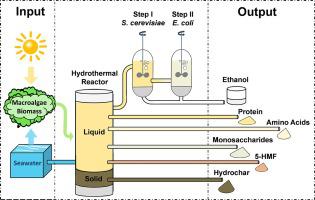当前位置:
X-MOL 学术
›
Energy Convers. Manag.
›
论文详情
Our official English website, www.x-mol.net, welcomes your feedback! (Note: you will need to create a separate account there.)
Biorefinery for the co-production of protein, hydrochar and additional co-products from a green seaweed Ulva sp. with subcritical water hydrolysis
Energy Conversion and Management ( IF 10.4 ) Pub Date : 2020-12-01 , DOI: 10.1016/j.enconman.2020.113380 Mark Polikovsky , Amichai Gillis , Efraim Steinbruch , Arthur Robin , Michael Epstein , Abraham Kribus , Alexander Golberg
Energy Conversion and Management ( IF 10.4 ) Pub Date : 2020-12-01 , DOI: 10.1016/j.enconman.2020.113380 Mark Polikovsky , Amichai Gillis , Efraim Steinbruch , Arthur Robin , Michael Epstein , Abraham Kribus , Alexander Golberg

|
Abstract Marine seaweeds are promising biomass feedstock for the co-production of food, energy and chemicals in a biorefinery. In this study, subcritical water hydrolysis (SWH) was applied to the biomass of green seaweed Ulva sp., fast-growing cosmopolitan seaweed. The SWH was done with seawater at 180 °C and 10.5 bar during 40 min with 8% w/w solid load. This treatment resulted in 211 ± 7 mg of hydrochar g−1 dry weight (DW) of Ulva sp. with higher heating value (HHV) double that of the initial biomass. The liquid fraction content per gram of Ulva DW included 5.2 ± 1.15 mg of 5-HMF; 24.1 ± 2.84 mg total monosaccharides (composed of 14.3 ± 1.78 mg glucose, 5.1 ± 0.41 mg rhamnose, 2.3 ± 0.41 mg fructose, 1 ± 0.06 mg xylose, 0.9 ± 0.08 mg galactose and 0.6 ± 0.11 mg glucuronic acid); 58 ± 11.78 mg protein (corresponding to 84.9 ± 13.2% of the total protein); and free amino acids (3.64 ± 0.07 mg leucine, 2.08 ± 0.13 mg arginine, 1.54 ± 0.01 mg isoleucine and 1.06 ± 0.03 mg alanine). Two-step fermentation optimization was done with Saccharomyces cerevisiae and Escherichia coli in Ulva hydrolysate following the SWH, with ethanol yield of 4.67 ± 0.76 mg g−1 DW Ulva. Based on these process results, some economics and sustainability indicators were estimated for large-scale macroalgae-based biorefinery. The required offshore areas for Ulva cultivation to satisfy the entire national demand in Israel for plant-based protein, char for electricity production (20% blend co-firing with coal), or ethanol for transportation (10% blend in gasoline), are 0.8%, 3.1% and 34.3%, respectively of the Israeli exclusive economic zone in the Mediterranean sea. The total revenue expected for the co-products derived from Ulva sp. via SWH varies between $0.26 and $1.06 kg−1 DW.
中文翻译:

生物精炼厂,用于联合生产来自绿色海藻 Ulva sp. 的蛋白质、水焦和其他副产品。用亚临界水水解
摘要 海洋海藻是一种很有前途的生物质原料,可用于在生物精炼厂中联合生产食品、能源和化学品。在这项研究中,亚临界水水解 (SWH) 被应用于绿色海藻 Ulva sp.,快速生长的世界海藻的生物量。SWH 是用海水在 180 °C 和 10.5 bar 下进行 40 分钟,固体负载为 8% w/w。这种处理导致石莼属的 211 ± 7 毫克油碳 g-1 干重 (DW)。具有更高的热值 (HHV),是初始生物质的两倍。每克石莼 DW 的液体组分含量包括 5.2 ± 1.15 mg 5-HMF;24.1 ± 2.84 mg 总单糖(由 14.3 ± 1.78 mg 葡萄糖、5.1 ± 0.41 mg 鼠李糖、2.3 ± 0.41 mg 果糖、1 ± 0.06 mg 木糖、0.9 ± 0.08 mg 半乳糖酸和 0.1 mg 葡萄糖酸组成)58 ± 11.78 mg 蛋白质(对应于 84.9 ± 13。总蛋白质的 2%);和游离氨基酸(3.64 ± 0.07 mg 亮氨酸、2.08 ± 0.13 mg 精氨酸、1.54 ± 0.01 mg 异亮氨酸和 1.06 ± 0.03 mg 丙氨酸)。在 SWH 之后,用 Saccharomyces cerevisiae 和大肠杆菌在石莼水解物中进行两步发酵优化,乙醇产量为 4.67 ± 0.76 mg g-1 DW 石莼。根据这些过程结果,对大型大型藻类生物精炼厂的一些经济和可持续性指标进行了估计。为满足以色列整个国家对植物蛋白、发电用焦炭(20% 与煤混合燃烧)或运输用乙醇(10% 与汽油混合)的需求,石莠种植所需的近海区域为 0.8 %、3.1% 和 34.3%,分别是以色列在地中海的专属经济区。来自 Ulva sp. 的联产品的预期总收入。通过 SWH 在 $0.26 到 $1.06 kg−1 DW 之间变化。
更新日期:2020-12-01
中文翻译:

生物精炼厂,用于联合生产来自绿色海藻 Ulva sp. 的蛋白质、水焦和其他副产品。用亚临界水水解
摘要 海洋海藻是一种很有前途的生物质原料,可用于在生物精炼厂中联合生产食品、能源和化学品。在这项研究中,亚临界水水解 (SWH) 被应用于绿色海藻 Ulva sp.,快速生长的世界海藻的生物量。SWH 是用海水在 180 °C 和 10.5 bar 下进行 40 分钟,固体负载为 8% w/w。这种处理导致石莼属的 211 ± 7 毫克油碳 g-1 干重 (DW)。具有更高的热值 (HHV),是初始生物质的两倍。每克石莼 DW 的液体组分含量包括 5.2 ± 1.15 mg 5-HMF;24.1 ± 2.84 mg 总单糖(由 14.3 ± 1.78 mg 葡萄糖、5.1 ± 0.41 mg 鼠李糖、2.3 ± 0.41 mg 果糖、1 ± 0.06 mg 木糖、0.9 ± 0.08 mg 半乳糖酸和 0.1 mg 葡萄糖酸组成)58 ± 11.78 mg 蛋白质(对应于 84.9 ± 13。总蛋白质的 2%);和游离氨基酸(3.64 ± 0.07 mg 亮氨酸、2.08 ± 0.13 mg 精氨酸、1.54 ± 0.01 mg 异亮氨酸和 1.06 ± 0.03 mg 丙氨酸)。在 SWH 之后,用 Saccharomyces cerevisiae 和大肠杆菌在石莼水解物中进行两步发酵优化,乙醇产量为 4.67 ± 0.76 mg g-1 DW 石莼。根据这些过程结果,对大型大型藻类生物精炼厂的一些经济和可持续性指标进行了估计。为满足以色列整个国家对植物蛋白、发电用焦炭(20% 与煤混合燃烧)或运输用乙醇(10% 与汽油混合)的需求,石莠种植所需的近海区域为 0.8 %、3.1% 和 34.3%,分别是以色列在地中海的专属经济区。来自 Ulva sp. 的联产品的预期总收入。通过 SWH 在 $0.26 到 $1.06 kg−1 DW 之间变化。



























 京公网安备 11010802027423号
京公网安备 11010802027423号